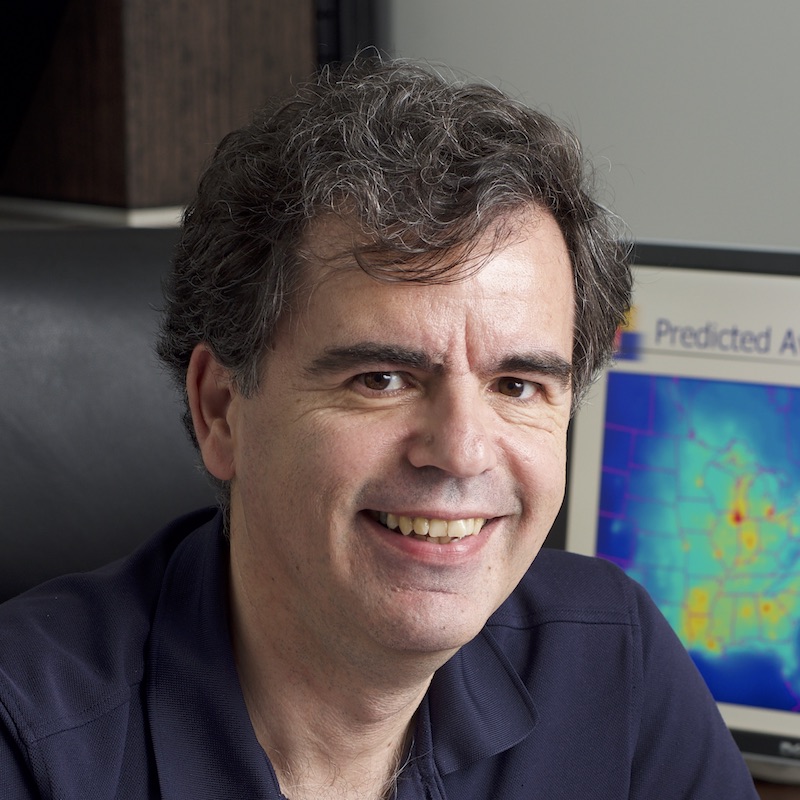
Spyros Pandis
Research Professor , Chemical Engineering
Bio
Professor Pandis received his M.S. and Ph.D. in Chemical Engineering (1991) from the California Institute of Technology after earning the Dipl. Ing., Chemical Engineering from the University of Patras, Greece. He held a joint appointment in the Department of Chemical Engineering and the Department of Engineering and Public Policy at Carnegie Mellon University, achieving the rank of Professor, until 2004, when he returned to Greece at the University of Patras. Dr. Pandis continues to hold the position of Research Professor at Carnegie Mellon University while serving as the Deputy Director of the Institute of Chemical Engineering, FORTH, Greece.Education
- Ph.D. ChemE, California Institute of Technology (1991)
- MS ChemE, California Institute of Technology (1988)
- BS ChemE University of Patras, Greece
Research
Pandis' research areas include the study of multiphase atmospheric chemistry as it relates to photochemical smog and acid deposition, as well as topics related to global climate change. He founded the Pandis Research Group, which connects two research branches. One branch in Patra (Greece) in the Chemical Engineering Department of the University of Patras and the Institute of Chemical Engineering (ICE) and one branch in Carnegie Mellon University in the Department of Chemical Engineering and the Department of Engineering and Public Policy. This group is part of the Center of Atmospheric Particulate Studies (CAPS).
Projects
Pandis' current projects include the Atmospheric Organic Particulate Matter, Air Quality and Climate Change Studies proposal (ATMOPACS) and the Pan-European Gas-AeroSOls-climate interaction study (PEGASOS). ATMOPACS is proposing an innovative new approach for the description of OA in both chemical transport and climate models that will be able to overcome the challenges posed by the chemical complexity of OA while capturing its essential features. The proposed framework is based on the two-dimensional representation of the OA in the volatility oxygen content“coordinate system.
The PEGASOS study is a large scale integrating project brings together most of the leading European research groups, with state-of the-art observational and modeling facilities, to quantify the magnitude of regional to global feedbacks between atmospheric chemistry and a changing climate and to reduce the corresponding uncertainty of the major ones. PEGASOS also aims is to identify mitigation strategies and policies to improve air quality while limiting their impact on climate change.
Publications
Donahue, N. M., L. N. Posner, D. M. Westervelt, Z. Li, M. Shrivastava, A. A. Presto, R. C. Sullivan, P. J. Adams, S. N. Pandis, and A. L. Robinson (2016) Where did this particle come from? Sources of particle number and mass for human exposure estimates, Issues in Env. Sci. Tech., 42, 35-71.
Kaltsonoudis, C., E. Kostenidou, K. Florou, M. Psichoudaki, and S. N. Pandis (2016) Temporal variability and sources of VOCs in urban areas of the eastern Mediterranean, Atmos. Chem. Phys., 16,14825-14842.
Panagiotopoulou A., P. Charalampidis, C. Fountoukis, C. Pilinis, and S. N. Pandis (2016) Comparison of PMCAMx aerosol optical depth predictions over Europe with AERONET and MODIS measurements, Geosci. Model Develop., 9, 4257-4272.
Baranizadeh E., B. N. Murphy, J. Julin, S. Falahat, C. L. Reddington, A. Arola, L. Ahlm, S. Mikkonen, C. Fountoukis, D. Patoulias, T. Hamburger, A. Laaksonen, S. N. Pandis, H. Vehkamaki, K. E. J. Lehtinen, and I. Riipinen (2016) Implementation of state-of-the-art ternary new-particle formation scheme to the regional chemical transport model PMCAMx-UF in Europe, Geosci. Model. Develop., 9, 2741-2754.
Diamantopoulou M., K. Skyllakou, and S. N. Pandis (2016) Estimation of the local and long-range contributions to particulate matter levels using continuous measurements in a single background site, Atmos. Environ., 134, 1-9.